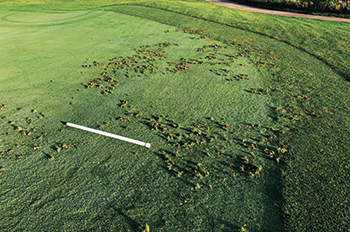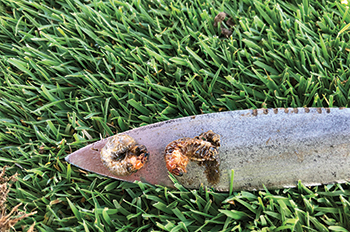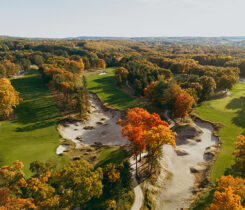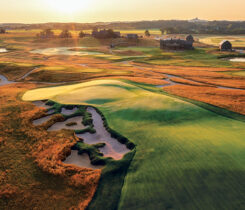Turf Pest of the Month: Contending with white grubs

Wildlife, such as skunks and raccoons, often pursue white grubs at nighttime, causing damage to the turf. (Photo courtesy of Doug Hausman)
Dakota Dunes in Dakota Dunes, S.D., has always struggled with a white grub problem, in part, due to its location between the Missouri River and the Sioux River, according to Doug Hausman, superintendent.
“We’ve always had issues with white grubs,” he says. “It wasn’t so much the grubs as the wildlife, such as skunks and raccoons, pursuing them in a moonlit buffet, tearing it up. Wherever we didn’t treat, we were getting torn up.”
Dakota Dunes features bentgrass tees, greens and fairways, all of which have been impacted by grub damage at some point over the years. To identify which type of grub is afflicting the turf, Hausman suggests looking at the backside of the grub and counting the raster pattern. He adds that to the eye, areas inflicted with grub damage look like wilt. “You’ll see areas that you don’t think you can get enough water on it, and you’ll peel it back, and you’ll just see the grubs,” he says.
About three years ago, Dakota Dunes started using Acelepryn for grub control, putting it down once in the springtime at a rate of about 7.8 ounces per acre. “Acelepryn has been bulletproof, assuming we get it on early enough,” Hausman says. “The longer it’s on, the better.”

For years, white grubs afflicted the turf at Dakota Dunes CC. (Photo courtesy of Doug Hausman)
While Hausman says the ideal time to make an application is in early to mid-April, often, Dakota Dunes puts down an application later to combine it with other products
“We’re pushing the envelope as far as timing, and we go later so that we can accomplish two or three things at once,” he says. “If you have limited resources, it makes sense to make one pass over the acreage versus three. We usually also put down a preemergent or a fungicide treatment for dollar spot.”
In addition to using Acelepryn on tees, fairways and greens, Dakota Dunes uses Merit or a generic product on 12 acres of rough. “Last year, early season was as good as we’ve seen. We saw very little damage,” Hausman says. “The critters had been looking for grubs but couldn’t get through — the turf was dense, and they couldn’t find anything.”
For fellow superintendents who have encountered problems with the pest, Hausman recommends watching out for thatch and keep up with sound cultural practices as needed. “That helps tremendously so that you can have as healthy a stand as possible to help stand up to whatever you may face,” he says.












